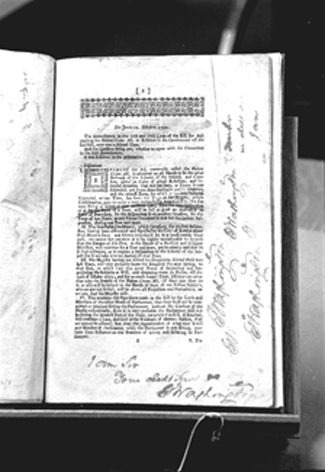The University Record, April 1, 1998
By Joanne Nesbit
News and Information Services
|
|
|
One of the collection of fakes at the Clements Library shows how forgers practiced their ‘art.’ Photo courtesy Clements Library |
April Fool!
Ninety years ago, at least one Michigander was chuckling to himself and saying “April Fool!” But not for long. The University’s Francis W. Kelsey put an end to that glee.
In 1891, rumors were rampant that marvelous archeological finds were being made in Montcalm County. Relics were being found at depths varying from 18 inches to four feet, most of them unearthed within a mile and a half of the town of Wyman. These discoveries were “authenticated” by affidavits made by witnesses.
In 1908 Kelsey described the area of the finds as “Šsoil, which in many places had never been turned, [and with] the openness of the country stripped of its large trees, and the paucity of inhabitants, the conditions seemed not unfavorable for the perpetration of an archeological fraud.”
Collectors were eager to purchase the artifacts, said to have been brought to the area by Egyptians, Phoenicians and Assyrians who, in a remote period, found their way from the drainage area of the Euphrates and Tigris across the seas, up the St. Lawrence and across the lakes to Michigan.
These forgeries, including caskets, clay tablets and pipes, were attributed to a James O. Scotford, a sign painter who at one time lived in Montcalm County and had relocated to Detroit by the time the “discoveries” were being made. His skill in “finding” these relics brought him great notoriety in the region, but never fooled Kelsey.
“The forger did not know enough about genuine relics of any class to make intelligent imitations,” Kelsey wrote in 1908. “He had never seen the things which he undertook to reproduce. He translated roughly into substance a medley of representations which he had found in books or magazines and which, in his working sketches, he jumbled together after the manner of a child. . .One of my friends thinks ‘forgeries’ too dignified a word to apply to such objects.”
Fakes, forgeries, or just the will to “fool” have been around for some time.
The Clements Library maintains a collection of “forgeries.” One item in the collection is a facsimile of a logbook said to have been written by Columbus during his first voyage. The book was written in English, a language with which Columbus was hardly familiar enough to keep such a journal. Another is a collection of 18th-century expense accounts on 19th-century paper. No matter where George Washington slept, his signature appeared everywhere, thanks to many forgers.
For a 1934 exhibition of “Facsimiles & Forgeries” at the Clements, the Library was offered the skin of the serpent that tempted Eve, prompting the curator to remark, “It is obvious that fraudulent people are not always the brainy scoundrels they are supposed to be.”


